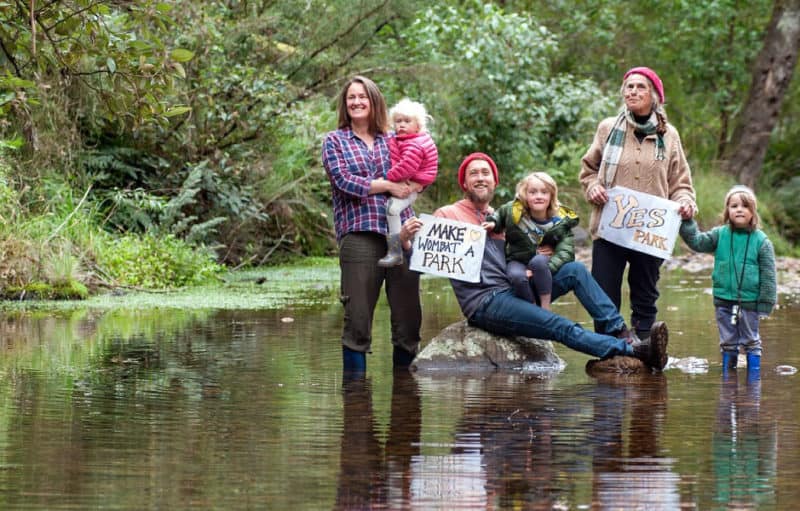PARK WATCH Article June 2022 |
Nature conservation and climate action can work together for better outcomes for both, explains Nature Conservation Officer Elizabeth Morison.
It’s time for an update – lots has happened since I last wrote about climate change and nature.
At the end of February 2022, our upstairs neighbours New South Wales and Queensland got pummelled by rain, that turned into floods, that swallowed ecosystems and communities, wreaking havoc all along the coast between Sydney and Brisbane.
That same week, the second of three reports that form the Sixth Assessment of the Intergovernmental Panel on Climate Change (IPCC) was released. It outlined the current state of play for impacts, vulnerability and adaptation to climate change. It showed that human-induced climate change, especially more frequent and intense extreme events, has already had huge consequences for nature, especially for unique and threatened systems.
Then, in early April, the third report was released, presenting climate change mitigation opportunities.
These followed the first report, which laid out the scientific basis for our current understanding of climate change. You might recall from the December 2021 edition of Park Watch, I explained why the United Nations had dubbed the report a ‘Code Red for Humanity’, and how Victoria’s climate policies responded to that warning (hint: they didn’t). I also argued that the best way to strengthen our pathway to our net zero by 2050 target is to phase out fossil fuels, and native forest logging.
Although much has happened, this conclusion remains unchanged.
In fact, the co-benefits of fossil fuel mitigation with nature conservation were championed as rationale for the best responses to climate change throughout the impacts, vulnerability and adaptation report and the mitigation report.
Both new reports ground climate science in its interactions with ecosystems and biodiversity: as global warming changes the climate baseline, and extremes fluctuate further outside of natural variability, environmental conditions will reach and exceed the resilience and adaptation limits of wildlife. Climate impacts and risk exacerbate trends of biodiversity loss and environmental degradation.
Already heat waves on land and in marine ecosystems have driven local species extinctions and mass mortality events. For example, at just 2°C of marine temperature increase, kelp forests die and cannot recover. Kelp forests are found throughout Victoria’s rocky reef ecosystems and provide the primary habitat for iconic marine animals like the striking Senator Wrasse, kaleidoscopic Giant Cuttlefish and wonderful Weedy Seadragon. When the kelp forests die, the fish leave, and the rock platforms are left open to colonisation by invasive species, or worse, empty of marine life.
Other impacts being felt in Victoria include: catastrophic bushfire seasons like we saw in 2019-20, which killed many of East Gippsland’s hollow-bearing trees that provide habitat for our most iconic arboreal mammals; sea level rise and storm surges turning dunes to plains in Port Fairy; and reduced snowfall leading to a decline in alpine biodiversity in Alpine National Park.
Each of these scenarios jeopardises the ecosystem’s ability to support wildlife and capture and store carbon dioxide. As climate change progresses, the impacts will shift further towards being irreversible, and nature will need to adapt.
In Victoria, this might look like biodiversity declines in hotspots like the Southern Ocean, desertification and deteriorating ecosystem health, shifts in seasonal timing, or species distribution towards cooler climate, poleward or to higher elevations in mountain regions. And things only get more complex when risks interact and compound.
When heat and drought occur together, vast areas of forest can die.
When sea level rise, storm surge, and heavy rainfall occur together, flooding can suffocate coastal ecosystems and cause groundwater salinisation, reducing the ability of the surviving plants to recover, and reducing the resilience of animals further up the food chain.
At 1.5°C of global warming, moderate impacts are predicted for nature. At 2°C, ecosystems and biodiversity will experience high impacts. Right now, we are on track for warming between 2.4°C (on the pledged pathway) and 2.7°C (under current global policies). At this level of warming, by the end of the century, up to a third of all terrestrial species could face very high risk of extinction. At 3°C of warming, risk of extinction for endemic species in biodiversity hotspots could increase tenfold.
These are unacceptable risks, especially for Victoria’s marine ecosystems, up to 70 per cent of which are endemic to the Southern Ocean.
The good news? With every increment of reduced global warming, threats to biodiversity decrease significantly. At 2°C warming, the portion of terrestrial species facing risk of extinction drops to 18 per cent, and at 1.5°C, just 14 per cent of terrestrial species are likely to be threatened with climate-related extinction.
This is where the opportunities lie to maximise the co-benefits of nature conservation and climate action. If implemented with justice and equity for communities in mind, combined strategies to reduce greenhouse gas emissions and promote biodiversity can enhance the success of each goal.
The mitigation report named improved forest management and reforestation as the best current examples to promote enhanced outcomes for nature and carbon sequestration in plants. It also identified soil carbon, and coastal wetland management and restoration as huge opportunities in sequestering blue carbon, and protecting inland habitat from coastal erosion and storm surges from extreme weather and sea level rise.
And lucky for us, Victoria is rich with forests and coastlines that can offer these co-benefits!
I know what you’re thinking. There’s a lot to do!
But do you know what I’m thinking? Now, we can do it together with our allies in the climate movement. What an exciting time to be part of this community working towards nature conservation and climate action!
Did you like reading this article? You can read the latest full edition of Park Watch magazine online.
Want to be kept up to date about this and other nature issues in Victoria? Subscribe to our email updates.
You can also receive our print magazine Park Watch four times a year by becoming a member. Find out more.
